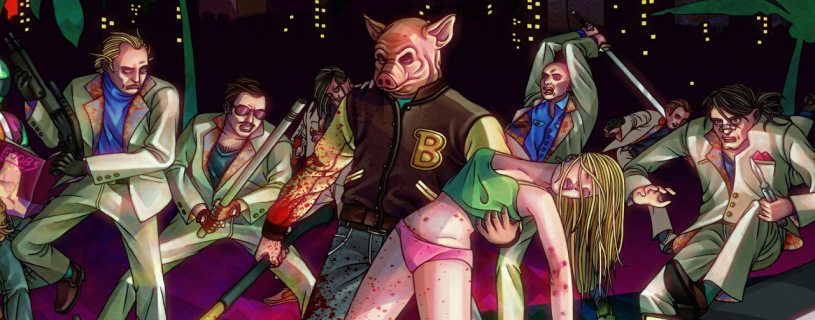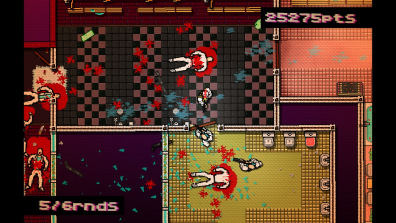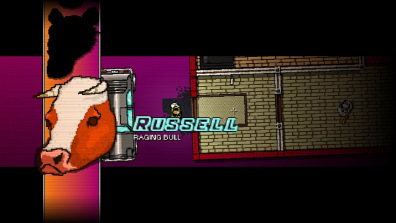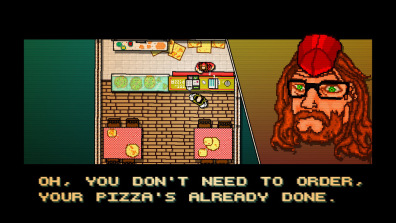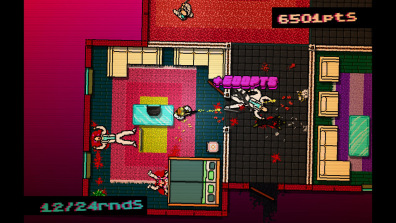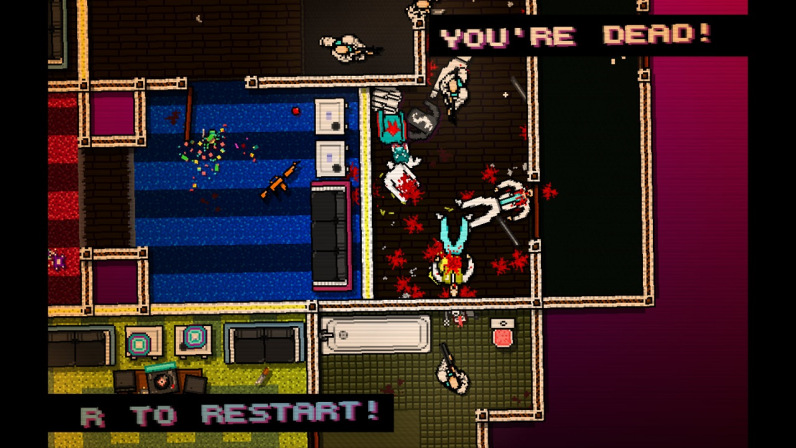Hotline Miami is a 2D top-down action game released by developer Dennaton Games in 2012 for Steam, before arriving on PlayStation 3 and Vita last year. Drawing heavy inspiration from 1980’s retro culture and music, the game incorporates elements of stealth, violence, and surrealist storytelling to create a unique gaming experience on whatever platform you choose to play it on.
At the start of the game you take control of a troubled, unnamed man commonly referred to as Jacket by fans, due to the iconic 80’s letterman jacket which he wears at all times. Jacket is plagued by visions of three masked men who judge him - and essentially you - on your increasingly violent actions throughout the duration of the running time. Little backstory is given on where Jacket comes from or where he is going in life, but at the onset it appears that he’s a hired killer, happy to slaughter anyone - so long as the pay is good enough.
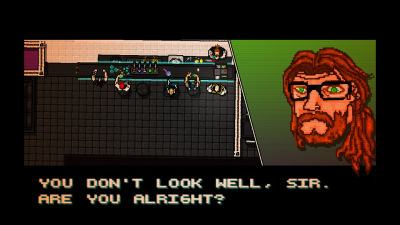 Jacket’s only contact with those who would hire him is through coded phone calls at the start of each chapter, directing him to his next target and location. It’s important to note that Hotline Miami incorporates the use of an unreliable narrator to intentionally blur the lines between reality and fabrication. Chapters don’t occur in chronological order, and dates frequently jump around - creating a sense of confusion around each event. Jacket is also a heavy drug user, and at the end of every chapter - regardless of where he goes - he meets the same hippy dealer that provides him with his next fix. You’re left to question what is in Jacket’s mind, and what is actually happening – and things only get more chaotic as the game progresses.
Jacket’s only contact with those who would hire him is through coded phone calls at the start of each chapter, directing him to his next target and location. It’s important to note that Hotline Miami incorporates the use of an unreliable narrator to intentionally blur the lines between reality and fabrication. Chapters don’t occur in chronological order, and dates frequently jump around - creating a sense of confusion around each event. Jacket is also a heavy drug user, and at the end of every chapter - regardless of where he goes - he meets the same hippy dealer that provides him with his next fix. You’re left to question what is in Jacket’s mind, and what is actually happening – and things only get more chaotic as the game progresses.
Each chapter presents you with an objective, which usually involves killing a specific target located on the top floor of a building and making it out alive. Before each mission you’re given the choice of a mask to wear for the duration, and each comes with its own unique perk that compliments your playstyle. How you make it through each floor of the building is largely up to you, and no two playthroughs of a level are ever the same. Hotline Miami is one of those games that’s happy to let you approach levels in your own way, similar to how other titles such as Transistorand Dark Souls 2 allow you to develop your own distinct playstyle.
The random nature of weapon placements and enemy positions means that each run through a level remains as challenging as the last, and if you try to rush through too quickly you’ll soon wind up dead. You’re as fragile as your enemies, and every hit is fatal – forcing you to carefully consider how to work through each area.
We should warn you now that you will die a lot before you reach the end of Hotline Miami. Much like Dark Souls, constant death makes up a huge part of the game, and enemies can quickly round corners with guns blazing, or kill you with a shot from off screen - which can sometimes be frustrating.
Either way, expect to find yourself re-spawning at the start of a floor on many an occasion. A perfect run might only take a matter of seconds, but more often than not you’ll require multiple attempts before you can successfully move on to the next stage. Playing fast and loose will only get you so far, as a single mistake will see you lying in a pool of your own blood on the floor.
Luckily, the start of each floor acts as a checkpoint, so you won’t have to start the entire chapter over with each death. Restarts are instantaneous too, with no loading times to break up the fluid and relentless gameplay.
In a great design choice by Dennaton, the soundtrack doesn’t restart with each death; the result is that the music becomes a driving hypnotic beat, creating a great sense of time-draining immersion.
The quality of the music can’t be overstated. A collaborative effort between hand-picked artists from around the globe results in a musical score which feels like it’s been ripped straight out of a 1980’s neon dance club drug binge. With contributions from notable chiptune artists such as M O O N, Sun Araw, Jasper Byrne, Scattle, Elliot Berlin, Perturbator, and El Huervo, there’s an eclectic array of catchy tunes on offer, which all work to create a retro 80’s electro-industrial score which marries perfectly with the visuals and fast-paced gameplay.
Along with Hotline Miami’s amazing musical score is a retro pixel-art 8-bit visual style which perfectly complements the violence and gameplay. Everything looks straight out of the 80s, and each level is populated with the bright neon colors of the era. There’s so much nostalgia packed into the game that it can easily challenge Grand Theft Auto: Vice City for retro dominance.
By now, you may have noticed that Hotline Miami shares some similar qualities with Nicolas Winding Refn’s 2011 film Drive. You’d be right to draw those parallels, as Hotline Miami is heavily influenced by Drive; Refn is even thanked in the credits for providing the creator with his inspiration. The game is filled with Easter eggs alluding to the connections between the two, and both feature an unnamed protagonist wearing a letterman jacket brutally murdering people against similar musical backdrops. If you’ve never seen Drive, we highly recommend that you finish reading this article and immediately find a way to watch it. You can thank us later.
However, much like Drive, Hotline Miami has been criticized for just how brutal the violence is for a videogame, and it’s something that has turned people off from fully enjoying what the game has to offer. While the artstyle deliberately seeks to mimic the 8-bit consoles of the time, there’s enough blood, guts and violence in 5 minutes of play to make Grand Theft Auto or even Manhunt seem pacifist by comparison. But it’s portrayed in an abstract way that serves the plot, instead of ever feeling gratuitous - and in an age where TV shows such as Game of Thrones continually seek to push the boundaries of what’s acceptable on the small screen, it’s hard to single out a videogame for displaying plenty of the red stuff.
Rather, it’s the concepts behind Hotline Miami that make the game more violent than the visuals let on; you’re provided with little explanation as to why you are killing these people, outside of the fact that someone over a phone told you 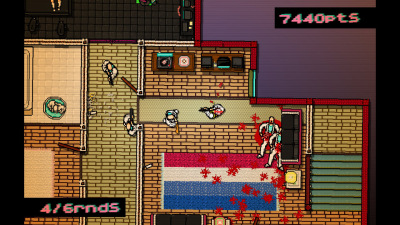 to do so. Debates continue to rage over the internet about what - if any - point the developer was trying to make, but thankfully the gameplay is so enjoyable that ultimately you needn’t concern yourself with worrying about it too deeply - unless you want to, of course.
to do so. Debates continue to rage over the internet about what - if any - point the developer was trying to make, but thankfully the gameplay is so enjoyable that ultimately you needn’t concern yourself with worrying about it too deeply - unless you want to, of course.
The good news is that Hotline Miami is available on both Steam and PSN, but if you’re playing on a PC then we would highly recommend you use the controller of your choice rather than mouse and keyboard; playing with a gamepad feels more appropriate and responsive than the sometimes-fiddly mouse aiming. Furthermore, while it isn’t a necessity, you will benefit playing with a decent set of headphones so that you’re able to fully appreciate the sound design and music.
Hotline Miami is a great game that you need to play. Everything comes together beautifully, resulting in an experience that you simply need to witness first-hand. We loved the tight controls and relentless difficulty that was just hard enough to keep us coming back for more, and we can’t overstate how well the soundtrack compliments the on-screen action. Every aspect is executed in such a way to create an engaging, addictive and polished title that is not only fun, but one that we have every confidence will still continue to be discussed a decade from now.
With a sequel coming out later this year, it’s the perfect time to jump in and find out what all the fuss is about. Get your best headphones on, dim the lights, and prepare yourself for a wild retro ride through an ultra-violent and utterly compelling masterpiece: a world of shoulder pads and murderous Miami nights.

